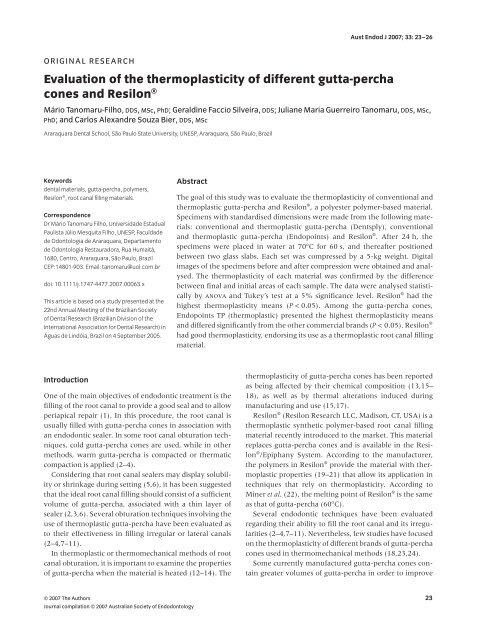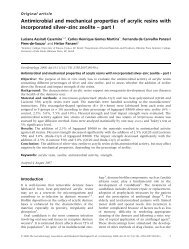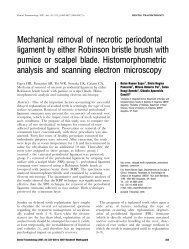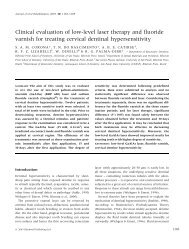Evaluation of the thermoplasticity of different gutta-percha cones and ...
Evaluation of the thermoplasticity of different gutta-percha cones and ...
Evaluation of the thermoplasticity of different gutta-percha cones and ...
You also want an ePaper? Increase the reach of your titles
YUMPU automatically turns print PDFs into web optimized ePapers that Google loves.
Blackwell Publishing IncMalden, USAAEJAustralian Endodontic Journal1329-1947© 2007 The Authors; Journal compilation © 2007 Australian Society <strong>of</strong> Endodontology? 2007••••2326Original ResearchThermoplasticity<strong>of</strong> Gutta-Percha <strong>and</strong> Resilon®M. Tanomaru-Filho et al.Aust Endod J 2007; 33: 23–26ORIGINAL RESEARCH<strong>Evaluation</strong> <strong>of</strong> <strong>the</strong> <strong>the</strong>rmoplasticity <strong>of</strong> <strong>different</strong> <strong>gutta</strong>-<strong>percha</strong><strong>cones</strong> <strong>and</strong> Resilon®Mário Tanomaru-Filho, DDS, MSc, PhD; Geraldine Faccio Silveira, DDS; Juliane Maria Guerreiro Tanomaru, DDS, MSc,PhD; <strong>and</strong> Carlos Alex<strong>and</strong>re Souza Bier, DDS, MScAraraquara Dental School, São Paulo State University, UNESP, Araraquara, São Paulo, BrazilKeywordsdental materials, <strong>gutta</strong>-<strong>percha</strong>, polymers,Resilon®, root canal filling materials.CorrespondenceDr Mário Tanomaru Filho, Universidade EstadualPaulista Júlio Mesquita Filho, UNESP, Faculdadede Odontologia de Araraquara, Departamentode Odontologia Restauradora, Rua Humaitá,1680, Centro, Araraquara, São Paulo, BrazilCEP:14801-903. Email: tanomaru@uol.com.brdoi: 10.1111/j.1747-4477.2007.00063.xThis article is based on a study presented at <strong>the</strong>22nd Annual Meeting <strong>of</strong> <strong>the</strong> Brazilian Society<strong>of</strong> Dental Research (Brazilian Division <strong>of</strong> <strong>the</strong>International Association for Dental Research) inÁguas de Lindóia, Brazil on 4 September 2005.AbstractThe goal <strong>of</strong> this study was to evaluate <strong>the</strong> <strong>the</strong>rmoplasticity <strong>of</strong> conventional <strong>and</strong><strong>the</strong>rmoplastic <strong>gutta</strong>-<strong>percha</strong> <strong>and</strong> Resilon ® , a polyester polymer-based material.Specimens with st<strong>and</strong>ardised dimensions were made from <strong>the</strong> following materials:conventional <strong>and</strong> <strong>the</strong>rmoplastic <strong>gutta</strong>-<strong>percha</strong> (Dentsply), conventional<strong>and</strong> <strong>the</strong>rmoplastic <strong>gutta</strong>-<strong>percha</strong> (Endopoints) <strong>and</strong> Resilon ® . After 24 h, <strong>the</strong>specimens were placed in water at 70°C for 60 s, <strong>and</strong> <strong>the</strong>reafter positionedbetween two glass slabs. Each set was compressed by a 5-kg weight. Digitalimages <strong>of</strong> <strong>the</strong> specimens before <strong>and</strong> after compression were obtained <strong>and</strong> analysed.The <strong>the</strong>rmoplasticity <strong>of</strong> each material was confirmed by <strong>the</strong> differencebetween final <strong>and</strong> initial areas <strong>of</strong> each sample. The data were analysed statisticallyby ANOVA <strong>and</strong> Tukey’s test at a 5% significance level. Resilon ® had <strong>the</strong>highest <strong>the</strong>rmoplasticity means (P < 0.05). Among <strong>the</strong> <strong>gutta</strong>-<strong>percha</strong> <strong>cones</strong>,Endopoints TP (<strong>the</strong>rmoplastic) presented <strong>the</strong> highest <strong>the</strong>rmoplasticity means<strong>and</strong> differed significantly from <strong>the</strong> o<strong>the</strong>r commercial br<strong>and</strong>s (P < 0.05). Resilon ®had good <strong>the</strong>rmoplasticity, endorsing its use as a <strong>the</strong>rmoplastic root canal fillingmaterial.IntroductionOne <strong>of</strong> <strong>the</strong> main objectives <strong>of</strong> endodontic treatment is <strong>the</strong>filling <strong>of</strong> <strong>the</strong> root canal to provide a good seal <strong>and</strong> to allowperiapical repair (1). In this procedure, <strong>the</strong> root canal isusually filled with <strong>gutta</strong>-<strong>percha</strong> <strong>cones</strong> in association withan endodontic sealer. In some root canal obturation techniques,cold <strong>gutta</strong>-<strong>percha</strong> <strong>cones</strong> are used, while in o<strong>the</strong>rmethods, warm <strong>gutta</strong>-<strong>percha</strong> is compacted or <strong>the</strong>rmaticcompaction is applied (2–4).Considering that root canal sealers may display solubilityor shrinkage during setting (5,6), it has been suggestedthat <strong>the</strong> ideal root canal filling should consist <strong>of</strong> a sufficientvolume <strong>of</strong> <strong>gutta</strong>-<strong>percha</strong>, associated with a thin layer <strong>of</strong>sealer (2,3,6). Several obturation techniques involving <strong>the</strong>use <strong>of</strong> <strong>the</strong>rmoplastic <strong>gutta</strong>-<strong>percha</strong> have been evaluated asto <strong>the</strong>ir effectiveness in filling irregular or lateral canals(2–4,7–11).In <strong>the</strong>rmoplastic or <strong>the</strong>rmomechanical methods <strong>of</strong> rootcanal obturation, it is important to examine <strong>the</strong> properties<strong>of</strong> <strong>gutta</strong>-<strong>percha</strong> when <strong>the</strong> material is heated (12–14). The<strong>the</strong>rmoplasticity <strong>of</strong> <strong>gutta</strong>-<strong>percha</strong> <strong>cones</strong> has been reportedas being affected by <strong>the</strong>ir chemical composition (13,15–18), as well as by <strong>the</strong>rmal alterations induced duringmanufacturing <strong>and</strong> use (15,17).Resilon ® (Resilon Research LLC, Madison, CT, USA) is a<strong>the</strong>rmoplastic syn<strong>the</strong>tic polymer-based root canal fillingmaterial recently introduced to <strong>the</strong> market. This materialreplaces <strong>gutta</strong>-<strong>percha</strong> <strong>cones</strong> <strong>and</strong> is available in <strong>the</strong> Resilon® /Epiphany System. According to <strong>the</strong> manufacturer,<strong>the</strong> polymers in Resilon ® provide <strong>the</strong> material with <strong>the</strong>rmoplasticproperties (19–21) that allow its application intechniques that rely on <strong>the</strong>rmoplasticity. According toMiner et al. (22), <strong>the</strong> melting point <strong>of</strong> Resilon ® is <strong>the</strong> sameas that <strong>of</strong> <strong>gutta</strong>-<strong>percha</strong> (60°C).Several endodontic techniques have been evaluatedregarding <strong>the</strong>ir ability to fill <strong>the</strong> root canal <strong>and</strong> its irregularities(2–4,7–11). Never<strong>the</strong>less, few studies have focusedon <strong>the</strong> <strong>the</strong>rmoplasticity <strong>of</strong> <strong>different</strong> br<strong>and</strong>s <strong>of</strong> <strong>gutta</strong>-<strong>percha</strong><strong>cones</strong> used in <strong>the</strong>rmomechanical methods (18,23,24).Some currently manufactured <strong>gutta</strong>-<strong>percha</strong> <strong>cones</strong> containgreater volumes <strong>of</strong> <strong>gutta</strong>-<strong>percha</strong> in order to improve© 2007 The Authors 23Journal compilation © 2007 Australian Society <strong>of</strong> Endodontology
Thermoplasticity <strong>of</strong> Gutta-Percha <strong>and</strong> Resilon®M. Tanomaru-Filho et al.Table 1 Endodontic filling materials used in <strong>the</strong> experimental groupsMaterialManufacturerDentsply (conventional<strong>gutta</strong>-<strong>percha</strong>)Dentsply TP (<strong>the</strong>rmoplastic<strong>gutta</strong>-<strong>percha</strong>)Endopoints (conventional<strong>gutta</strong>-<strong>percha</strong>)Endopoints TP (<strong>the</strong>rmoplastic<strong>gutta</strong>-<strong>percha</strong>)Resilon®Dentsply Indústria e Comércio Ltda.,Petrópolis, RJ, BrazilDentsply Indústria e Comércio Ltda.,Petrópolis, RJ, BrazilEndopoints Indústria E Comércio Ltda.,Paraiba do Sul, RJ, BrazilEndopoints Indústria E Comércio Ltda.,Paraiba do Sul, RJ, BrazilPentron Clinical Technologies, Wallingford,PT, USA4.8 kg0.2 kgFigure 1 Apparatus used for <strong>the</strong> test.Glass slabs<strong>the</strong>ir <strong>the</strong>rmoplastic properties (18). As <strong>the</strong>se properties areessential for <strong>the</strong> success <strong>of</strong> numerous root canal fillingtechniques, <strong>the</strong> purpose <strong>of</strong> this study was to assess<strong>the</strong> <strong>the</strong>rmoplasticity <strong>of</strong> <strong>different</strong> commercially availablebr<strong>and</strong>s <strong>of</strong> conventional <strong>and</strong> <strong>the</strong>rmoplastic <strong>gutta</strong>-<strong>percha</strong><strong>cones</strong> compared with Resilon ® syn<strong>the</strong>tic polymer.Materials <strong>and</strong> methodsFor <strong>the</strong>rmoplasticity analysis, five cylindrical specimens(10 mm in diameter, 1.5-mm thick) were made from eachexamined br<strong>and</strong> <strong>of</strong> <strong>gutta</strong>-<strong>percha</strong> or Resilon ® , as describedin Table 1.The material samples were kept in water at 70°C for60 s using a <strong>the</strong>rmometer-controlled heating apparatus(Righetto e Cia., Campinas, São Paulo, Brazil).The heated materials were <strong>the</strong>n placed into st<strong>and</strong>ardisedrings with <strong>the</strong> above-mentioned dimensions, <strong>and</strong>were pressed between two glass slabs under a controlled<strong>and</strong> constant force <strong>of</strong> 0.5 N for 1 min. Thereafter, <strong>the</strong> specimenswere removed from <strong>the</strong> moulds, <strong>the</strong> excess materialwas trimmed <strong>and</strong> <strong>the</strong> dimensions were checked using adigital pachymeter. The specimens were kept at a temperaturebetween 25–30°C for 24 h <strong>and</strong> <strong>the</strong>n returned to <strong>the</strong>heating apparatus at 70°C for 60 s. Next, each sample wasonce again positioned between two glass slabs, <strong>and</strong> a 5-kgweight was placed on top <strong>of</strong> <strong>the</strong> slabs to produce a compressiveforce for 2 min (Fig. 1). Digital images <strong>of</strong> eachspecimen were obtained before <strong>and</strong> after compression,<strong>and</strong> were examined using an image analysis s<strong>of</strong>tware(UTHSCSA Image Tool for Windows version 3.0, SanAntonio, TX, USA) to determine its area. The <strong>the</strong>rmoplasticity<strong>of</strong> <strong>the</strong> materials was determined by <strong>the</strong> differencebetween final <strong>and</strong> initial areas <strong>of</strong> each specimen.The data were analysed statistically by ANOVA, <strong>and</strong> multiplecomparisons among <strong>the</strong> experimental groups weredone by Tukey’s post-hoc test. The significance level wasset at 5%.Figure 2 Means in mm 2 (±SD) <strong>of</strong> <strong>the</strong> differences between initial <strong>and</strong> finalareas <strong>of</strong> each obturation material used in <strong>the</strong> experimental groups. Meansfollowed by <strong>the</strong> same letter did not present statistically significant difference(P > 0.05).ResultsMeans <strong>and</strong> st<strong>and</strong>ard deviation for <strong>the</strong> differences betweeninitial <strong>and</strong> final areas <strong>of</strong> each material are shown inFigure 2. Statistical analysis showed that Resilon ® had <strong>the</strong>highest <strong>the</strong>rmoplasticity means, while Endopoints conventional<strong>gutta</strong>-<strong>percha</strong> had <strong>the</strong> lowest <strong>the</strong>rmoplasticitymeans <strong>of</strong> all tested materials (P < 0.05). Among <strong>the</strong> <strong>gutta</strong><strong>percha</strong><strong>cones</strong>, Endopoints TP (<strong>the</strong>rmoplastic) (EndopointsIndústria E Comércio Ltda., Paraiba do Sul, RJ, Brazil) presented<strong>the</strong> highest <strong>the</strong>rmoplasticity means <strong>and</strong> differedsignificantly from <strong>the</strong> o<strong>the</strong>r commercially available br<strong>and</strong>s(P < 0.05).DiscussionBecause few studies (18,22) have focused on <strong>the</strong> differencesbetween commercially available br<strong>and</strong>s <strong>of</strong> <strong>gutta</strong><strong>percha</strong>,no specific methodology for testing <strong>the</strong> <strong>the</strong>rmoplasticity<strong>of</strong> <strong>gutta</strong>-<strong>percha</strong> has been described. In this study,<strong>the</strong> American Dental Association specification No. 57 (forendodontic sealers) was adapted to <strong>gutta</strong>-<strong>percha</strong> testing.(ISO 6876:2002 – Dental Root Canal Sealing Materials). Toevaluate <strong>the</strong> flowing ability <strong>of</strong> endodontic sealers, a 120-g24 © 2007 The AuthorsJournal compilation © 2007 Australian Society <strong>of</strong> Endodontology
M. Tanomaru-Filho et al. Thermoplasticity <strong>of</strong> Gutta-Percha <strong>and</strong> Resilon®weight is applied. The findings <strong>of</strong> preliminary studiesshowed that <strong>the</strong> force required to provide a significantincrease in <strong>the</strong> diameter <strong>of</strong> heated <strong>gutta</strong>-<strong>percha</strong> specimensshould be greater than 3 kg. In <strong>the</strong> present study, a 5-kgweight was used.In search <strong>of</strong> a better root canal filling, obturation methodsusing heat-s<strong>of</strong>tened <strong>gutta</strong>-<strong>percha</strong> associated with athin layer <strong>of</strong> endodontic sealer have been emphasised(6,25). The lateral condensation method using cold <strong>gutta</strong><strong>percha</strong><strong>cones</strong> may result in voids, which are less likely inwarm <strong>gutta</strong>-<strong>percha</strong> techniques (2,3,25).Resilon ® , a recently launched product, is a syn<strong>the</strong>ticpolymer-based root canal filling material. In <strong>the</strong> presentstudy, Resilon ® had greater <strong>the</strong>rmoplasticity than <strong>the</strong><strong>gutta</strong>-<strong>percha</strong> <strong>cones</strong> (P < 0.05), which supports its claimed<strong>the</strong>rmoplastic properties.According to Schilder et al. (13), <strong>gutta</strong>-<strong>percha</strong> has twoendo<strong>the</strong>rmic peaks. The first peak occurs between 42 <strong>and</strong>49°C <strong>and</strong> corresponds with <strong>the</strong> transformation from <strong>the</strong>beta phase to <strong>the</strong> alpha phase, while <strong>the</strong> o<strong>the</strong>r peak occursbetween 53 <strong>and</strong> 59 o C when <strong>the</strong> material changes from<strong>the</strong> alpha phase to <strong>the</strong> amorphous phase. Miner et al.(22) observed that <strong>the</strong> melting point <strong>of</strong> Resilon ® <strong>and</strong><strong>gutta</strong>-<strong>percha</strong> is 60°C. Combe et al. (17) compared <strong>the</strong>endo<strong>the</strong>rmic peaks <strong>of</strong> non-industrialised <strong>gutta</strong>-<strong>percha</strong> to15 commercially available br<strong>and</strong>s <strong>of</strong> <strong>gutta</strong>-<strong>percha</strong> using<strong>the</strong> temperature <strong>of</strong> 70°C. For <strong>the</strong> dental <strong>gutta</strong>-<strong>percha</strong> formulations,no endo<strong>the</strong>rmic peak occurred at temperatureshigher than 51°C. Venturi et al. (24) investigated threecommercially available br<strong>and</strong>s <strong>of</strong> <strong>gutta</strong>-<strong>percha</strong> in accessorycanals at <strong>different</strong> temperatures, <strong>and</strong> found thatmaterial flow greater than 1.2 mm occurred only at temperatureshigher than 60°C. Based on <strong>the</strong> findings <strong>of</strong> <strong>the</strong>sestudies, a temperature <strong>of</strong> 70°C was chosen for <strong>the</strong> presentstudy.Two <strong>gutta</strong>-<strong>percha</strong> br<strong>and</strong>s were tested in this study. Aconventional <strong>and</strong> a <strong>the</strong>rmoplastic type <strong>of</strong> <strong>cones</strong> <strong>of</strong> eachbr<strong>and</strong> (as specified by <strong>the</strong>ir manufacturers) were used.Both br<strong>and</strong>s are recommended for warm <strong>gutta</strong>-<strong>percha</strong>obturating techniques, especially when <strong>the</strong>rmomechanicalcompactors are used. Among <strong>the</strong> <strong>gutta</strong>-<strong>percha</strong> cone,Endopoints TP showed <strong>the</strong> best <strong>the</strong>rmoplasticity. Conventional<strong>and</strong> TP Dentsply (Dentsply Indústria e ComércioLtda., Petrópolis, RJ, Brazil) <strong>cones</strong> had similar results toeach o<strong>the</strong>r.Gutta-<strong>percha</strong> is a natural polymer that undergoesindustrial processing <strong>and</strong> addition <strong>of</strong> o<strong>the</strong>r substancesbefore its application in dentistry. It has been shown that<strong>the</strong> <strong>the</strong>rmoplastic properties <strong>of</strong> <strong>gutta</strong>-<strong>percha</strong> dependdirectly on its composition, being more pronounced inits pure form than in <strong>the</strong> manufactured version (16).O<strong>the</strong>r studies have reported that <strong>the</strong> amount <strong>of</strong> inorganicfillers added, as well as <strong>the</strong>rmal alterations inducedduring cone manufacture, may affect <strong>the</strong> material’sproperties (15,17,18).The findings <strong>of</strong> a recent chemical <strong>and</strong> X-ray analysis<strong>of</strong> five commercially available br<strong>and</strong>s <strong>of</strong> <strong>gutta</strong>-<strong>percha</strong>showed great variation in <strong>the</strong> amounts <strong>of</strong> zinc oxide (from84.30 ± 0.50% to 66.50 ± 0.50%) <strong>and</strong> <strong>gutta</strong>-<strong>percha</strong> (from14.5 ± 0.70% to 20.4 ± 0.40%). In ano<strong>the</strong>r study involving<strong>the</strong> same br<strong>and</strong>s, to evaluate <strong>the</strong>ir <strong>the</strong>rmoplasticity<strong>and</strong> ability to fill simulated lateral canals, Gurgel-Filhoet al. (18) verified that <strong>cones</strong> with greater percentages <strong>of</strong><strong>gutta</strong>-<strong>percha</strong> provided <strong>the</strong> best results.Although <strong>the</strong> materials evaluated in this study were<strong>different</strong> from those tested by Gurgel-Filho et al. (26), <strong>the</strong>discrepancies in <strong>the</strong> composition <strong>of</strong> <strong>gutta</strong>-<strong>percha</strong> <strong>cones</strong>may explain <strong>the</strong> observed results.The <strong>the</strong>rmoplastic properties <strong>of</strong> Resilon ® are attributedto <strong>the</strong> addition <strong>of</strong> polycaprolactone, which has a meltingpoint <strong>of</strong> 60°C (21). Our results suggest that Resilon ® , presentedto <strong>the</strong> market as an alternative to <strong>gutta</strong>-<strong>percha</strong>, canbe used in <strong>the</strong>rmoplastic techniques <strong>of</strong> root canal obturation,such as <strong>the</strong> hybrid technique proposed by Taggeret al. (4).The present study may be considered as an initial modelfor <strong>the</strong>rmoplasticity evaluation. Fur<strong>the</strong>r research isrequired to increase <strong>the</strong> accuracy <strong>and</strong> st<strong>and</strong>ardisation <strong>of</strong><strong>the</strong> analysis <strong>of</strong> <strong>the</strong> <strong>the</strong>rmoplastic properties <strong>of</strong> <strong>gutta</strong><strong>percha</strong><strong>and</strong> similar root canal filling materials.References1. Schilder H. Filling root canals in three dimensions. DentClin North Am 1967; 11: 723–44.2. Wu M-K, Kastáková A, Wesselink PR. Quality <strong>of</strong> cold <strong>and</strong>warm <strong>gutta</strong>-<strong>percha</strong> fillings in m<strong>and</strong>ibular premolars. IntEndod J 2001; 34: 485–91.3. Jarrett IS, Marx D, Covey D, Karmazin M, Lavin M,Gound T. Percentage <strong>of</strong> canals filled in apical cross sections– an in vitro study <strong>of</strong> seven obturation techniques. IntEndod J 2004; 37: 392–8.4. Tagger M, Tamse A, Katz A, Korzen BH. <strong>Evaluation</strong> <strong>of</strong> <strong>the</strong>apical seal produced by a hybrid root canal filling method,combining lateral condensation <strong>and</strong> <strong>the</strong>rmatic compaction.J Endod 1984; 10: 299–303.5. Peters DD. Two-year in vitro solubility evaluation <strong>of</strong> four<strong>gutta</strong>-<strong>percha</strong> sealer obturation techniques. J Endod 1986;12: 139–45.6. Kontakiotis EG, Wu M-K, WesselinkPR. Effect <strong>of</strong> sealerthickness on long-term sealing ability: a 2-year follow-upstudy. Int Endod J 1997; 30: 307–12.7. Dulac KA, Nielsen CJ, Tomazic TJ, Ferrillo PJ Jr, HattonJF.Comparison <strong>of</strong> <strong>the</strong> obturation <strong>of</strong> lateral canals by six techniques.J Endod 1999; 25: 376–80.8. Goldberg F, Massone EJ, Esmoris M, Alfie D. Comparison <strong>of</strong><strong>different</strong> techniques for obturating experimental internal© 2007 The Authors 25Journal compilation © 2007 Australian Society <strong>of</strong> Endodontology
Thermoplasticity <strong>of</strong> Gutta-Percha <strong>and</strong> Resilon®M. Tanomaru-Filho et al.resorptive cavities. Endod Dent Traumatol 2000; 16: 116–21.9. Goldberg F, Artaza LP, De Silvio A. Effectiveness <strong>of</strong> <strong>different</strong>obturation techniques in filling <strong>of</strong> simulated lateralcanals. J Endod 2001; 27: 362–4.10. Clinton K, Himel VT. Comparison <strong>of</strong> a warm <strong>gutta</strong>-<strong>percha</strong>obturation technique <strong>and</strong> lateral condensation. J Endod2001; 27: 692–5.11. Bowman C, Baumgartner JC. Gutta-<strong>percha</strong> obturation<strong>of</strong> lateral grooves <strong>and</strong> depressions. J Endod 2002; 28:220–3.12. Goodman A, Schilder H, Aldrich W. The <strong>the</strong>rmomechanicalproperties <strong>of</strong> <strong>gutta</strong>-<strong>percha</strong> II. The history <strong>and</strong> molecularchemistry <strong>of</strong> <strong>gutta</strong>-<strong>percha</strong>. Oral Surg 1974; 37: 954–61.13. Schilder H, Goodman A, Aldrich W. The <strong>the</strong>rmomechanicalproperties <strong>of</strong> <strong>gutta</strong>-<strong>percha</strong>. III. Determination <strong>of</strong> phasetransition temperatures for <strong>gutta</strong>-<strong>percha</strong>. Oral Surg OralMed Oral Pathol 1974; 38: 109–14.14. Schilder H, Goodman A, Aldrich W. The <strong>the</strong>rmomechanicalproperties <strong>of</strong> <strong>gutta</strong>-<strong>percha</strong>. V. Volume changes in bulk<strong>gutta</strong>-<strong>percha</strong> as a function <strong>of</strong> temperature <strong>and</strong> its relationshipto molecular phase transformation. Oral Surg OralMed Oral Pathol 1985; 59: 285–96.15. Marciano J, Michailesco P, Charpentier E, Carrera LC,Abadie MJM. Thermomechanical analysis <strong>of</strong> dental <strong>gutta</strong><strong>percha</strong>.J Endod 1992; 18: 263–70.16. Kolokuris I, Arvanitoyannis I, Blanshard JMV, Robinson C.Thermal analysis <strong>of</strong> commercial <strong>gutta</strong>-<strong>percha</strong> using <strong>different</strong>ialscanning colorimeter <strong>and</strong> dynamic mechanical <strong>the</strong>rmalanalysis. J Endod 1992; 18: 4–9.17. Combe EC, Cohen BD, Cummings K. Alpha <strong>and</strong> beta forms<strong>of</strong> <strong>gutta</strong>-<strong>percha</strong> in products for root canal filling. Int EndodJ 2001; 34: 447–51.18. Gurgel-Filho ED, Feitosa JPA, Gomes BPFA, Ferraz CCR,Souza Filho FJ, Teixeira FB. Assessment <strong>of</strong> <strong>different</strong> <strong>gutta</strong><strong>percha</strong>br<strong>and</strong>s during <strong>the</strong> filling <strong>of</strong> simulated lateral canals.Int Endod J 2006; 39: 113–18.19. Shipper G, Orstavik D, Teixeira FB, TropeM. An evaluation<strong>of</strong> microbial leakage in roots filled with a <strong>the</strong>rmoplastic syn<strong>the</strong>ticpolymer-based root canal filling material (Resilon).J Endod 2004; 30: 341–7.20. Shipper G, Teixeira FB, Arnold RR, Trope M. Periapicalinflammation after coronal microbial inoculation <strong>of</strong> dogroots filled with <strong>gutta</strong>-<strong>percha</strong> or Resilon. J Endod 2005; 31:91–6.21. Tay FR, Pashley DH, Williams MC et al. Susceptibility <strong>of</strong> apolycaprolactone-based root canal filling material to degradation.I. Alkaline hydrolysis. J Endod 2005; 31: 593–8.22. Miner MR, Berzins DW, Bahcall JK. A comparison <strong>of</strong> <strong>the</strong>rmalproperties between <strong>gutta</strong>-<strong>percha</strong> <strong>and</strong> a syn<strong>the</strong>tic polymerbased root canal filling material (Resilon). J Endod2006; 32: 683–6.23. Tagger M, Gold A. Flow <strong>of</strong> various br<strong>and</strong>s <strong>of</strong> <strong>gutta</strong>-<strong>percha</strong><strong>cones</strong> under in vitro <strong>the</strong>rmomechanical compactation.J Endod 1988; 14: 115–20.24. Venturi M, Di Lenarda R, Breschi L. An ex vivo comparison<strong>of</strong> three <strong>different</strong> <strong>gutta</strong>-<strong>percha</strong> <strong>cones</strong> when compacted at<strong>different</strong> temperatures: rheological considerations in relationto <strong>the</strong> filling <strong>of</strong> lateral canals. Int Endod J 2006; 39:648–56.25. Wu M-K, Özok AR, Wesselink PR. Sealer distribution inroot canals obturated by three techniques. Int Endod J2000; 33: 340–5.26. Gurgel-FilhoED, Feitosa JPA, Teixeira FB, Monteiro dePaulaRC, Araújo Silva JB, Souza Filho FJ. Chemical <strong>and</strong>X-ray analyses <strong>of</strong> five br<strong>and</strong>s <strong>of</strong> dental <strong>gutta</strong>-<strong>percha</strong> cone.Int Endod J 2003; 36: 302–7.26 © 2007 The AuthorsJournal compilation © 2007 Australian Society <strong>of</strong> Endodontology






